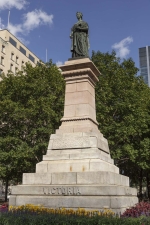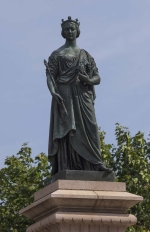Marshall Wood
Monument à la reine Victoria
1869
Presentation of the artwork
Ten years after Victoria Square was created, a visit by a member of the royal family, Prince Arthur, afforded the opportunity to launch a public subscription for the purpose of erecting a monument to Queen Victoria in the square named after her. The commission was awarded to the London sculptor Marshall Wood.The artist portrayed Victoria in 1837, when she was ascending to the throne at age 18. Unlike models inspired by classicism, in which royal figures were portrayed as divinities invested with superhuman powers, Wood presents a head of state who is slender, even fragile, in a pose that is simple and solemn. This portrayal of Victoria corresponds perfectly to the symbol of dignity that the queen embodied for her subjects. She is adorned with her royal attributes: she wears the royal crown with five lilies, an element that recalls that France ruled England for centuries. In her dignified pose, she carries in her left hand, at chest height, a laurel crown, and her right hand bears her sceptre, a symbol of royalty. This monument was the second commemorative monument erected in Montreal, after the Nelson column (1809).
Associated events
Victoria I, the granddaughter of George III, succeeded William IV as monarch of Great Britain and Ireland, from 1837 and 1901, and empress of India, from 1876 to 1901. Her reign, now called the Victorian era, lasted almost 64 years and was marked by the expansion of the British Empire and the industrial revolution. At the time when she ascended to the throne, the empire had just conquered new colonies and it stood alone as the world’s top economic and maritime power. In this context, the queen directed both domestic and foreign affairs, often against her ministers’ advice. Her reign was characterized by the defence and maintenance of conservative values, both political and social.
Marshall Wood
Marshall Wood, born in 1820 in Manchester, England, began to work professionally in London in 1854. His career took flight in 1867, when his sculpture The Song of the Shirt was exhibited at the Salon of the Paris World Fair. The event provided him with recognition throughout Europe and ensured commissions from the colonies and other continents, including that for the statue of Queen Victoria in Montréal. From 1871 to 1873, Wood lived in Canada, where he produced, among other things, the funerary monument erected by the Honourable P.-J.-O. Chauveau, leader of the Senate, to the memory of his three daughters in the Ursulines Chapel in Québec City, as well as a number of busts. Wood died in Brighton, England, in 1882.
Awards and honours
- Médaille d'or à l'exposition universelle de Paris pour l'œuvre «The song of the shirt» (La chanson de la chemise). , 1867
Presentation of the artwork
Ten years after Victoria Square was created, a visit by a member of the royal family, Prince Arthur, afforded the opportunity to launch a public subscription for the purpose of erecting a monument to Queen Victoria in the square named after her. The commission was awarded to the London sculptor Marshall Wood.The artist portrayed Victoria in 1837, when she was ascending to the throne at age 18. Unlike models inspired by classicism, in which royal figures were portrayed as divinities invested with superhuman powers, Wood presents a head of state who is slender, even fragile, in a pose that is simple and solemn. This portrayal of Victoria corresponds perfectly to the symbol of dignity that the queen embodied for her subjects. She is adorned with her royal attributes: she wears the royal crown with five lilies, an element that recalls that France ruled England for centuries. In her dignified pose, she carries in her left hand, at chest height, a laurel crown, and her right hand bears her sceptre, a symbol of royalty. This monument was the second commemorative monument erected in Montreal, after the Nelson column (1809).
Associated events
Victoria I, the granddaughter of George III, succeeded William IV as monarch of Great Britain and Ireland, from 1837 and 1901, and empress of India, from 1876 to 1901. Her reign, now called the Victorian era, lasted almost 64 years and was marked by the expansion of the British Empire and the industrial revolution. At the time when she ascended to the throne, the empire had just conquered new colonies and it stood alone as the world’s top economic and maritime power. In this context, the queen directed both domestic and foreign affairs, often against her ministers’ advice. Her reign was characterized by the defence and maintenance of conservative values, both political and social.
Marshall Wood
Marshall Wood, born in 1820 in Manchester, England, began to work professionally in London in 1854. His career took flight in 1867, when his sculpture The Song of the Shirt was exhibited at the Salon of the Paris World Fair. The event provided him with recognition throughout Europe and ensured commissions from the colonies and other continents, including that for the statue of Queen Victoria in Montréal. From 1871 to 1873, Wood lived in Canada, where he produced, among other things, the funerary monument erected by the Honourable P.-J.-O. Chauveau, leader of the Senate, to the memory of his three daughters in the Ursulines Chapel in Québec City, as well as a number of busts. Wood died in Brighton, England, in 1882.
Awards and honours
- Médaille d'or à l'exposition universelle de Paris pour l'œuvre «The song of the shirt» (La chanson de la chemise). , 1867






